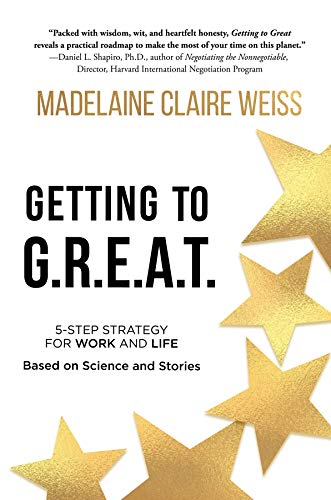
There are countless books, articles, podcasts, videos, and related items that aim to help people achieve meaning and purpose in their life and work. While many of these resources are excellent, it’s somewhat less common to find those that are also practical, and written by people who have relevant professional/academic backgrounds and experience.
That is one of the key factors that drew me to a new book by Madelaine Claire Weiss, Getting to G.R.E.A.T.: A 5-Step Strategy For Work and Life; Based on Science and Stories. I initially met Madelaine several years ago, and was impressed by a workshop she later gave for a local leadership group here in suburban Maryland.
What sealed my interest and curiosity about the book was a front cover endorsement by her former colleague, Harvard professor Daniel L. Shapiro, founder and director of the Harvard International Negotiation Program. I edited Daniel’s 2016 Leader to Leader article “Leading your Team to Peak Performance: How to Negotiate the Nonnegotiable,” and in 2005 I reviewed Beyond Reason: Using Emotions as You Negotiate, for USA TODAY. The book was co-authored with the late, legendary Harvard Law School professor Roger Fisher, co-founder of the Harvard Negotiation Project, and co-author of the classic book Getting to Yes.
I recently asked Madelaine questions about her book, and practical ways that tools presented in it could be put into use immediately as people continue to navigate unprecedented times.
For a non-specialist audience, how would you briefly characterize the research, conclusions, and central point of your book Getting to G.R.E.A.T.?
At some point not so long ago, I began to wonder why so many clients so different from one another (age, ethnicity, gender, occupation…) were doing so well with whatever it was I was doing with them.
After all, my toolkit was so diverse (traditional/evolutionary psychology, brain science, eastern/western philosophy, career and business management/development…), and there was no telling what I’d pull out for any one of them based on my best sense of the need before us at the time.
So I asked myself what was it that was working? What was the common denominator to their success? And what I found was something that we have known at least as far back as Darwin, which has become the first line and central thesis of the book:
“A great life depends on a great fit between who we are and the environments in which we work and live.”
The world has always belonged to those who fit best with their environments, and the acronym “G.R.E.A.T.” outlines the 5 step strategy for creating that optimal fit.
The concept/metaphor of the working surface is intriguing. Whether or not it leads to psychologist Mihaly Csikszentmihalyi’s concept of flow, as mentioned on page 135, how can the working surface be applied when we have to get something done, especially if we face difficulties; perhaps in starting a project, or ending one?
Research suggests that, left to its own devices, the mind wanders at least 50% of the time and I’ve see it as high as 70%.
The bulk of this wandering is into past regrets and future worries, both of which can negatively affect our mood and productivity.
Deliberately anchoring our attention to the working surface (where the paint brush hits the woodwork, the soapy sponge hits the dish, the fingers hit the keys…) keeps our mind on the ball and prevents mistakes, adding hours to the day, and who doesn’t want that?
As for starting a project, once we see that we have simply placed our attention somewhere else instead—maybe somewhere that doesn’t make us as anxious as beginning a new project naturally could—it becomes easier to put our attention on the new challenge instead.
Ending a task is also a challenge for many. The brain does not multitask. The brain cannot think about the last task and the next task all at the same time. So it uses enormous amounts of energy going back and forth endlessly between the two, and then people wonder why they are so tired!
Releasing the attention from the previous activity—taking charge of the placement of the attention in general—frees up all of that wasted energy for much better things, and can make a huge difference in work and life.
Is there one particular exercise in the book that you would recommend for people who have apprehensions or anxieties about what might be called the distant future? This might be 20 or more years out, and encompass not only the personal, but also uncertainties about the state of the world at that time, even though it might be essentially unknowable at present?
In Ernest Becker’s Pulitzer Prize winning book The Denial of Death, we learn how humans in general have a deeply rooted existential worry about the future, and our place in it.
For those who suffer this concern more than some others, I would recommend a simple two-step process for immediate reset and relief.
The first would be the Power Breathing exercise. This 30 second mindset reset takes us out of lower brain reactivity, putting the higher executive functioning brain in charge.
Then we ask, “Is there something to be done here?” Maybe the answer is:
- Yes, and then we can take care of whatever that is.
- Or yes, but not by you so we delegate.
- Or yes, but not today so we make a plan.
- Or yes, but you already did it, nothing further for you to do.
- And, sometimes the answer is a simple no, there is nothing for anyone to do.
For the last two especially, then we simply breathe and go about our day. Because existential anxiety can be free-floating, we have to be very careful not to overthink whatever the generalized anxiety attaches itself to.
Sometimes, a simple “Oh, there goes anxiety” is all that is needed for that happier, healthier, productive life we all want and can have.
